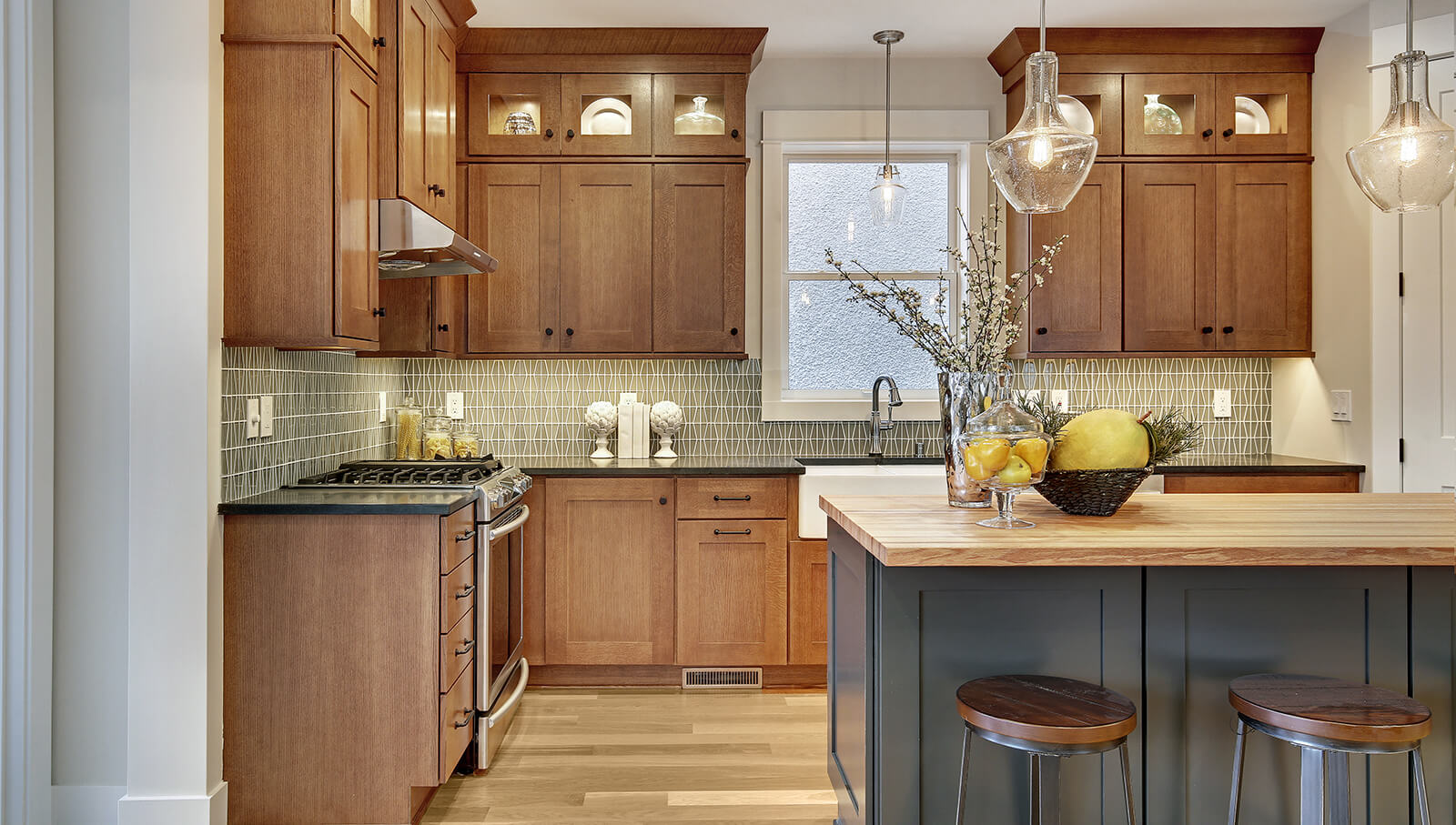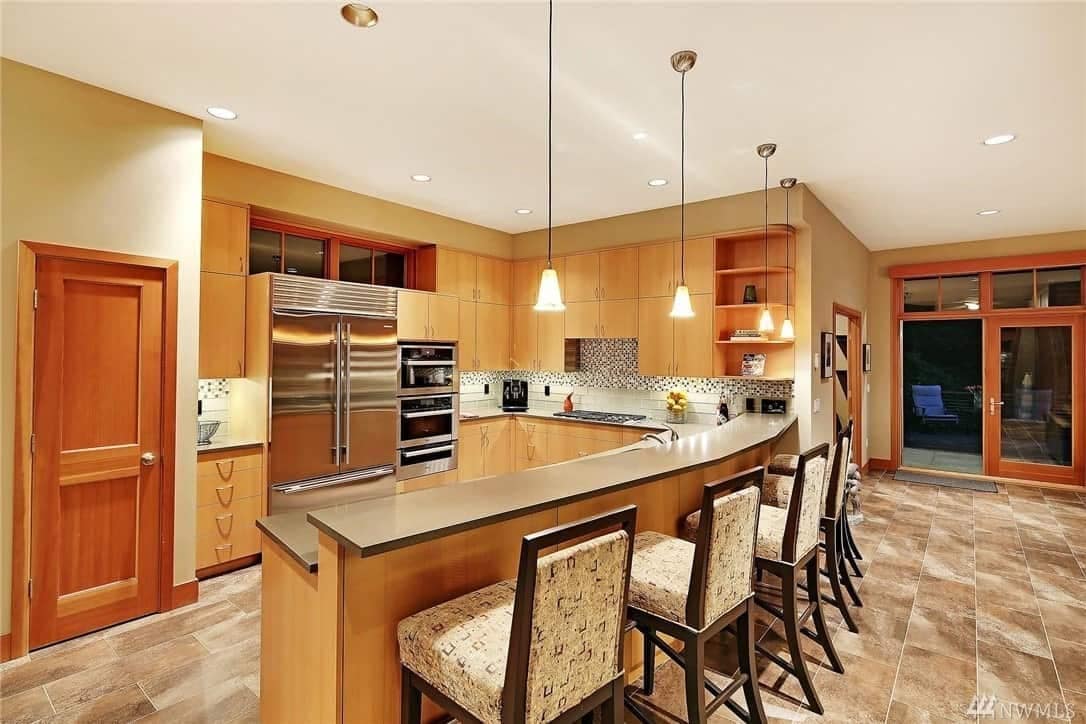The Essence of Craftsman Style Kitchen Cabinets: Craftsman Style Kitchen Cabinets Plans

Craftsman style kitchen cabinets, with their timeless appeal and enduring elegance, are a testament to the enduring allure of handcrafted artistry. Emerging in the early 20th century, they represent a harmonious blend of functionality and aesthetics, reflecting the spirit of the Arts and Crafts movement. These cabinets embody a philosophy of simplicity, honesty, and connection to nature, captivating homeowners with their warm, inviting ambiance.
The Defining Characteristics of Craftsman Style Kitchen Cabinets
Craftsman style kitchen cabinets are characterized by their distinctive design elements, reflecting a commitment to quality craftsmanship and natural materials. They stand apart from other styles, such as contemporary or traditional, through their unique blend of simplicity and sophistication.
- Simple, Functional Design: Craftsman cabinets prioritize functionality, featuring clean lines, uncluttered surfaces, and a focus on practicality. They eschew elaborate ornamentation in favor of understated elegance.
- Natural Materials: Craftsman cabinets are crafted from natural materials, primarily wood such as oak, cherry, or maple. These woods are prized for their durability, beauty, and ability to age gracefully.
- Handcrafted Details: Craftsmanship is evident in the meticulous details of Craftsman cabinets. Hand-cut dovetail joints, mortise and tenon construction, and hand-applied finishes contribute to their enduring quality and unique character.
- Warm, Earthy Color Palette: The color palette of Craftsman cabinets typically features warm, earthy tones such as browns, greens, and yellows, complementing the natural beauty of the wood and creating a welcoming atmosphere.
- Simple Hardware: Craftsman cabinets often feature simple, functional hardware made from metal or wood. Knobs and pulls are typically unadorned, reflecting the style’s emphasis on practicality and understated elegance.
The Materials Used in Craftsman Kitchen Cabinets
The materials used in Craftsman kitchen cabinets are integral to their character and longevity.
- Solid Wood: Craftsman cabinets are predominantly crafted from solid wood, primarily oak, cherry, or maple. These hardwoods are known for their durability, strength, and ability to withstand the test of time. Their natural grain patterns add warmth and character to the cabinets.
- Natural Finishes: Craftsman cabinets are often finished with natural oils, stains, or waxes that enhance the wood’s natural beauty and protect it from wear and tear. These finishes allow the wood’s grain and color to shine through, creating a warm and inviting ambiance.
- Durable Hardware: The hardware used on Craftsman cabinets is typically made from durable materials such as metal or wood. It is designed to be functional and long-lasting, complementing the cabinets’ overall aesthetic.
Crafting Your Craftsman Kitchen Cabinet Plans

The blueprint of your dream kitchen, meticulously crafted, awaits. Your vision, translated into tangible form, will guide the construction of your Craftsman kitchen cabinets. This plan, a testament to your taste and functionality, will be your compass as you navigate the journey of creating a timeless and beautiful space.
Layout and Functionality
The layout of your kitchen cabinets is a crucial element in determining the functionality and aesthetic appeal of your Craftsman kitchen. A well-designed layout maximizes space, ensures efficient workflow, and enhances the overall beauty of the room.
- Consider the size and shape of your kitchen. A smaller kitchen may benefit from a galley-style layout with cabinets on either side of a central walkway, maximizing storage while maintaining an open feel. Larger kitchens may accommodate an island or peninsula, offering additional work and storage space.
- Think about the flow of traffic in your kitchen. Design your layout to facilitate a smooth and logical flow, ensuring that you can easily move between different work areas without obstruction.
- Evaluate your storage needs. Consider the types of appliances you will be using and the amount of cookware, dishes, and food items you need to store. This will help you determine the size and configuration of your cabinets.
Cabinet Configurations
The choice of cabinet configurations plays a vital role in achieving the desired functionality and aesthetic appeal of your Craftsman kitchen. Various configurations can be tailored to meet specific needs and preferences, while maintaining the essence of the Craftsman style.
- Base cabinets provide essential storage for cookware, dishes, and other kitchen essentials. Consider incorporating a combination of drawer and door configurations for optimal accessibility and organization.
- Wall cabinets offer valuable vertical storage space for glassware, china, and other items. Open shelves can be incorporated for display purposes, adding a touch of rustic charm.
- Corner cabinets, strategically placed, maximize storage in often underutilized areas. Consider lazy Susan units for easy access to the contents of these cabinets.
- Island cabinets, if space permits, offer additional storage and countertop space, creating a central hub for food preparation and gathering.
Aesthetic Appeal, Craftsman style kitchen cabinets plans
Beyond functionality, the aesthetic appeal of your Craftsman kitchen cabinets is paramount. The choice of materials, finishes, and hardware can significantly impact the overall look and feel of your kitchen.
- Consider using natural wood species such as oak, cherry, or maple, which are synonymous with the Craftsman style. These woods have a rich grain pattern and warm tones that create a welcoming and inviting atmosphere.
- Opt for finishes that complement the natural beauty of the wood. Stains in warm shades of brown, honey, or amber can enhance the grain pattern and create a timeless look.
- Choose hardware that complements the Craftsman style. Simple, functional hardware with a touch of rustic charm, such as oil-rubbed bronze or hammered metal, can enhance the aesthetic appeal of your cabinets.
Incorporating Elements
Beyond the cabinets themselves, various elements can be integrated into your plan to enhance the overall Craftsman aesthetic of your kitchen. These elements work together to create a harmonious and cohesive design.
- Lighting plays a crucial role in enhancing the ambiance of your kitchen. Consider incorporating pendant lights over the island or task lighting under wall cabinets to provide both functional and decorative illumination.
- A backsplash can add a touch of visual interest and protect the wall behind your stove and sink. Choose a backsplash material that complements the Craftsman style, such as natural stone, tile with a rustic finish, or a simple subway tile pattern.
Bringing Craftsman Kitchen Cabinets to Life

The transformation of carefully crafted plans into tangible, functional works of art is a rewarding process. Bringing your Craftsman kitchen cabinet plans to life requires a blend of precision, skill, and an appreciation for the timeless beauty of this design style.
Building the Cabinets
Building Craftsman kitchen cabinets involves a series of steps, each contributing to the final product’s quality and character.
- Cutting and Assembling the Wood: The process begins with meticulously cutting the wood to precise dimensions using a table saw or circular saw. Craftsman cabinets often utilize traditional joinery techniques like mortise and tenon, dovetail, or pocket hole joinery. These methods ensure strong, durable joints that enhance the cabinet’s longevity and aesthetic appeal.
- Installing Cabinet Doors and Drawers: Cabinet doors and drawers are crafted using similar techniques, often featuring raised panels or simple, clean lines. They are typically constructed with frame-and-panel construction, where a solid wood frame surrounds a central panel. This construction method adds strength and visual interest.
- Finishing the Cabinets: Craftsman cabinets are known for their natural wood finishes, often highlighting the wood’s grain and texture. Popular options include stains, varnishes, and waxes. The application of these finishes requires careful attention to detail to achieve a smooth, even coat that enhances the wood’s beauty.
- Installing the Cabinets: Once the cabinets are finished, they are carefully installed using a level and measuring tape to ensure a precise fit. Proper installation is crucial for both functionality and aesthetics, ensuring the cabinets align correctly and provide ample storage space.
Achieving the Distinctive Look of Craftsman Cabinets
The essence of Craftsman style lies in its attention to detail and its emphasis on craftsmanship.
- Hand-Cut Joinery: Hand-cut joinery, such as mortise and tenon, dovetail, or finger joints, is a hallmark of Craftsman furniture. These techniques require skill and precision, resulting in strong and visually appealing joints that showcase the artisan’s craftsmanship.
- Exposed Hardware: Craftsman cabinets often feature exposed hardware, such as hinges, knobs, and pulls. These hardware elements are carefully selected to complement the cabinet’s design, adding a touch of functionality and aesthetic appeal.
- Natural Wood Finishes: The use of natural wood finishes, such as stains, varnishes, and waxes, allows the wood’s grain and texture to shine through. This approach emphasizes the beauty of the wood itself and creates a warm, inviting ambiance.
Incorporating Sustainable and Eco-Friendly Practices
The Craftsman ethos emphasizes a connection with nature and a respect for the environment.
- Using Sustainable Wood: Choosing wood from sustainably managed forests is a crucial step in minimizing the environmental impact of cabinet construction. Sustainable forestry practices ensure that forests are harvested responsibly, allowing for regeneration and maintaining biodiversity.
- Reducing Waste: Careful planning and precise cutting techniques help minimize waste during the construction process. Utilizing scraps for smaller projects or donating them to woodworking schools or community workshops can further reduce waste.
- Using Non-Toxic Finishes: Selecting non-toxic finishes, such as water-based stains and varnishes, reduces the release of harmful chemicals into the environment. These finishes are also safer for homeowners and their families, particularly in a space where food is prepared.
Craftsman style kitchen cabinets plans – Right, so you’re thinking about crafting those artisan-style kitchen cabinets, eh? That’s a top-notch idea, but you might also want to consider a bit of DIY for your workspace. If you’re after a tidy setup, check out this diy computer desk with file cabinet guide.
It’ll help you whip up a desk with built-in storage, keeping your study space organised and your tools handy for those kitchen cabinet projects.
Crafting the perfect craftsman style kitchen is a real labour of love, innit? From the warm wood tones to the intricate detailing, every element needs to be just right. And when it comes to colour schemes, the classic pairing of white cabinets and black backsplash always hits the spot.
This timeless combo adds a touch of sophistication, letting those craftsman cabinets really shine. So, if you’re going for that traditional vibe with a modern twist, you can’t go wrong with this classic colour scheme.
